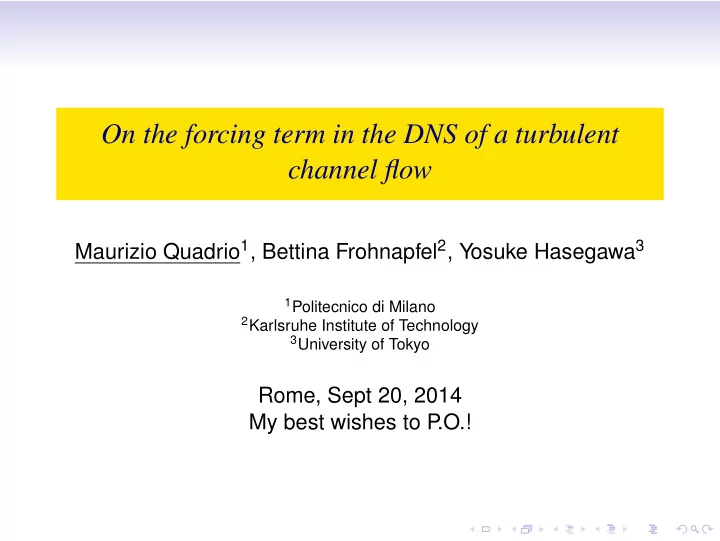

On the forcing term in the DNS of a turbulent channel flow Maurizio Quadrio 1 , Bettina Frohnapfel 2 , Yosuke Hasegawa 3 1 Politecnico di Milano 2 Karlsruhe Institute of Technology 3 University of Tokyo Rome, Sept 20, 2014 My best wishes to P .O.!
The need for a forcing term in DNS • NS equations alone cannot push fluid through the duct • Forcing term must be added to mimick pump / gravity / etc
Forcing term is "arbitrary" • Popular choices are constant flow rate (CFR) and constant pressure gradient (CPG) • Often equivalent on physical grounds • Known difference on practical grounds • Different realizations, statistics are the same
Important when comparing two different flows Example: turbulent drag reduction by spanwise oscillating walls "Turbulence intensity is destroyed"
Important when comparing two different flows Example: turbulent drag reduction by spanwise oscillating walls "Turbulence intensity is destroyed"
Important when comparing two different flows Example: turbulent drag reduction by spanwise oscillating walls "Turbulence intensity is destroyed"
Important when comparing two different flows Example: turbulent drag reduction by spanwise oscillating walls "Turbulence intensity is destroyed"
CFR or CPG? Pre-determines the global energy budget for drag reduction • Potential source of confusion • Concerns both DNS and experiments • CFR: pumping power is reduced with drag reduction • CPG: pumping power is increased with drag reduction
A further option: CPI The Money-vs-Time plane (JFM 2012, 2014)
Question Does the choice of the forcing term affect the statistics of the same flow?
Finding the answer • Large spatio-temporal DNS channel databases for CFR, CPG, CPI • DNS code: mixed-discretization solver • Channel flow at Re τ ≈ 200 • L x × L y × L z = 4 π h × 2 h × 2 π h • ∆ x + = 9 . 6 ∆ z + = 4 . 8 ∆ y + = 0 . 8 − 4 . 9 • Sample size: T + = 100 , 000 at ∆ t + = 1
No obvious changes (obviously!) forcing term flow driven with measured CFR Re b = 3173 Re τ = 199 . 01 CPG Re τ = 200 Re τ = 199 . 89 CPI Re Π = 6500 Re τ = 199 . 49 20 3 2.5 CFR 15 CPG CFR CPI 2 CPG CPI rms U 10 1.5 ’ u 1 5 0.5 0 0 0 50 100 150 0 50 100 150 200 + + y y
Focus on wall friction Comparison with Lenaers et al, PoF 2012 2 10 1 10 0 10 -1 10 P( τ w ’) -2 10 -3 10 CFR -4 10 CPG CPI -5 10 -6 10 -4 -2 0 2 4 σ
An in-depth look 0 10 -1 10 CFR -2 CPG 10 CPI -3 10 -4 10 P( τ w ’) -5 10 -6 10 -7 10 -8 10 -9 10 -15 -10 -5 0 5 10 15 σ
Space-time autocorrelation of wall friction Red: CFR; black: CPG; green: CPI 12 10 8 ∆ x/h 6 4 2 0 0 50 100 150 200 250 300 + ∆ t
Differences appear in Lagrangian frame only! One-dimensional space or time correlations are mostly unaffected 1 1 CFR CFR 0.8 0.8 CPG CPG CPI CPI 0.6 0.6 R R 0.4 0.4 0.2 0.2 0 0 0 2 4 6 0 50 100 150 200 250 300 + ∆ x/h ∆ t
Statistical significance? 12 10 8 ∆ x/h 6 4 2 0 0 50 100 150 200 250 300 + ∆ t
Link to vortical structures? Integral timescale of "lagrangian" correlation: lifetime of near-wall structures 1 0.8 CFR CPG CPI 0.6 R 0.4 0.2 0 0 50 100 150 200 250 + ∆ t
Conclusions • Choice of forcing term does leave a statistical footprint • Most evident (so far) in lagrangian frame • Relevance?
A 18-years-old pair of skies Gratefully remembering my first workshop in Aussois (1997), organized by P.O.
Recommend
More recommend